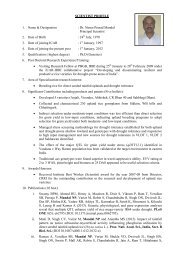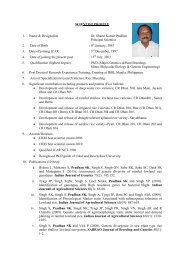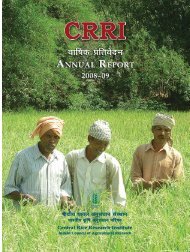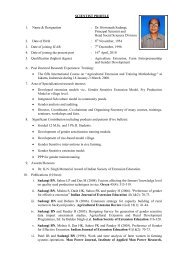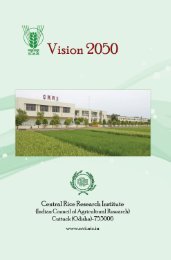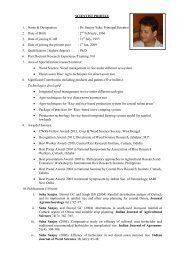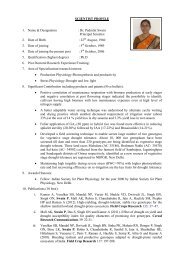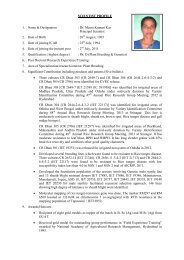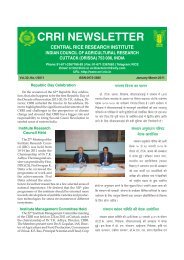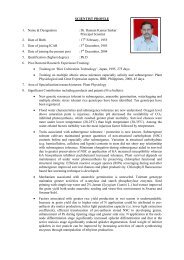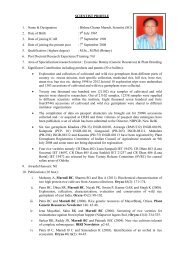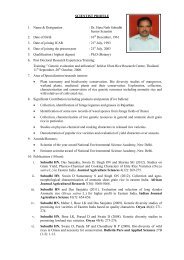Central Rice Research Institute Annual report...2011-12
Central Rice Research Institute Annual report...2011-12
Central Rice Research Institute Annual report...2011-12
You also want an ePaper? Increase the reach of your titles
YUMPU automatically turns print PDFs into web optimized ePapers that Google loves.
Quick diagnosis of <strong>Rice</strong> Tungro Disease (RTD)<br />
through molecular marker and other<br />
techniques<br />
Six rice cultivars (viz., Annada, IR64, TN1, Jaya,<br />
Tapaswini and Shatabdi,) were tested on three different<br />
dates of sowing and transplanting during the season<br />
. Observations based on visual symptoms were corroborated<br />
by insect transmission and the diagnostic<br />
was confirmed through PCR test involving specific<br />
primers for ‘<strong>Rice</strong> Tungro Bacilliform virus’.<br />
Characterization of sheath blight isolates<br />
The sheath blight disease was artificially inoculated<br />
in 1025 test entries on to the sheath of seven plants in<br />
each row of in entries. Observations revealed that 55<br />
entries namely, NSN-2 150, 191, 210, 249, 271, 273, 318,<br />
369, 393, 444, 467, 487, 495, 507, 519, 542, 545; HSN27,<br />
71, 84, 90, 114; NSN-H 2, 13, 14, 30, 36, 38, 68, 69, 74<br />
and DSN 6, 39, 42, 60, 67 showed sheath blight symptom<br />
in SES score of 0-3.<br />
Molecular characterization of insect pest<br />
populations<br />
The genetic variability among 70 yellow stem borer<br />
(YSB) populations was assessed using molecular markers.<br />
These 70 YSB populations were collected from fifteen<br />
districts of Odisha namely, Khurda, Balasore, Puri,<br />
Kendrapara, Cuttack, Jagatsinghpur, Mayurbhanj,<br />
Deogarh, Sambalpur, Sonepur, Bolangir, Phulbani,<br />
Nayagarh, Boudh and Dhenkanal. Ten microsatellite<br />
and fifteen rDNA specific markers were used to amplify<br />
genomes of the YSB populations. A total of <strong>12</strong>2<br />
bands were amplified, all being polymorphic. Twenty<br />
eight unique bands were identified which will be useful<br />
for developing diagnostic marker. Genetic similarity<br />
among YSB populations varied from 0.08 to 0.97<br />
with an average of 0.50, indicating that wide genetic<br />
variation exists between YSB populations. YSB population<br />
in Srikhandpur of Balasore district showed highest<br />
genetic similarity with YSB population of Soro in<br />
Balasore district while YSB population from Ersama,<br />
Jagatsinghpur district showed least genetic similarity<br />
with Vellipadia, Balasore district. Cluster analysis using<br />
UPGMA, dendrogram classified all the 70 rice YSB<br />
populations into three major clusters at 30% level of<br />
genetic similarity. All the individual populations of YSB<br />
included in the study could be distinguished precisely<br />
from each in pair wise comparison over all the 25<br />
primers.<br />
82 CRRI ANNUAL REPORT 2011-<strong>12</strong>



